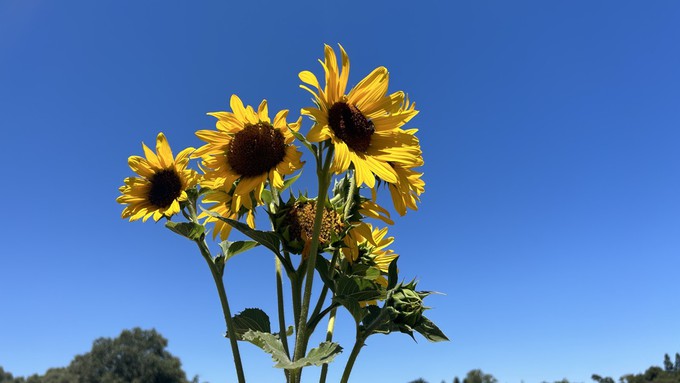
Intense heat will challenge midsummer garden

Sunflowers at least thrive in summer heat. Make sure the rest of the garden is prepared to handle triple-digit temps. Kathy Morrison
Is your garden ready for a blast furnace? Near-record temperatures will torch much of Northern California this weekend, including Sacramento.
According to the National Weather Service, Sacramento can expect highs of 107 degrees on Saturday and Sunday with another triple-digit day on Monday. Temperatures will peak each day in the late afternoon – 3 to 5 p.m. – and will stay hot most of the evening.
The NWS has declared an Excessive Heat Warning for the Sacramento region with “dangerous heat” expected from 11 a.m. Saturday through 11 p.m. Sunday. Some communities may see 114 degrees. Overnight temperatures will stay in the 70s, getting mornings off to a warm start.
“Very high risk of heat stress or illness for entire population,” warned the NWS Sacramento office Saturday morning. “Stay hydrated. Avoid being outdoors in the sun 10 a.m. to 6 p.m.”
“Consider canceling outdoor activities during the heat of the day,” added the weather service. “Stay in a cool place.”
Atmospheric conditions will make these high-heat days feel even hotter; 107 will seem more like 110 or higher. However, our local rivers are still running fast and extremely cold due to snow melt; be careful near our waterways, the weather service adds.
By Monday (fingers crossed), our Delta breeze will return. Tuesday through Thursday are expected to be in the mid 90s – normal for mid July. At 93 degrees, Tuesday may be the best day to visit the State Fair. Friday is expected to start a streak of seven consecutive triple-digit days.
Meanwhile, our gardens are in survival mode:
* Keep your vegetable garden watered, mulched and weeded. Water before 8 a.m. to reduce the chance of fungal infection and to conserve moisture.
* Prioritize watering. Provide extra irrigation to recent transplants, vegetables, trees and shrubs.
* Check soil moisture before irrigation. Clay soils tend to hold moisture longer, looking dry on top but wet underneath.
* Mulch helps keep soil moist longer and roots cooler; add 2 to 3 inches of mulch if necessary.
* Weeds love this hot weather and will quickly go to seed. Whack them at their roots, aiming a hoe about an inch below the surface. (But wait until a cool morning midweek to tackle this chore.)
* Skip feeding vegetables and flowers until midweek when temperatures are cooler. Make sure to water deeply before fertilizing.
* Don’t let tomatoes, peppers or eggplant dry out completely; that can lead to blossom end rot. Deeply water veggies two to three times a week.
* Harvest vegetables promptly to encourage plants to produce more. Squash especially tends to grow rapidly in hot weather. Keep an eye on zucchini.
* Bees tend to rest during extreme heat, so new squash blossoms may not be pollinated. Either pollinate by hand with a small paintbrush or harvest the blossoms.
* Pinch back chrysanthemums for bushy plants and more flowers in September.
* Remove spent flowers from roses, daylilies and other bloomers as they finish flowering.
* Pinch off blooms from basil so the plant will grow more leaves.
* Cut back lavender after flowering to promote a second bloom.
* One good thing about hot days: Most lawns stop growing when temperatures top 95 degrees. Keep mower blades set on high.
Comments
0 comments have been posted.Sacramento Digs Gardening to your inbox.
Sites We Like
Garden Checklist for week of April 21
This week there’s plenty to keep gardeners busy. With no rain in the immediate forecast, remember to irrigate any new transplants.
* Weed, weed, weed! Get them before they flower and go to seed.
* April is the last chance to plant citrus trees such as dwarf orange, lemon and kumquat. These trees also look good in landscaping and provide fresh fruit in winter.
* Smell orange blossoms? Feed citrus trees with a low dose of balanced fertilizer (such as 10-10-10) during bloom to help set fruit. Keep an eye out for ants.
* Apply slow-release fertilizer to the lawn.
* Thoroughly clean debris from the bottom of outdoor ponds or fountains.
* Spring brings a flush of rapid growth, and that means your garden is really hungry. Feed shrubs and trees with a slow-release fertilizer. Or mulch with a 1-inch layer of compost.
* Azaleas and camellias looking a little yellow? If leaves are turning yellow between the veins, give them a boost with chelated iron.
* Trim dead flowers but not leaves from spring-flowering bulbs such as daffodils and tulips. Those leaves gather energy to create next year's flowers. Also, give the bulbs a fertilizer boost after bloom.
* Pinch chrysanthemums back to 12 inches for fall flowers. Cut old stems to the ground.
* Mulch around plants to conserve moisture and control weeds.
* From seed, plant beans, beets, cantaloupes, carrots, corn, cucumbers, melons, radishes and squash.
* Plant onion sets.
* In the flower garden, plant seeds for asters, cosmos, celosia, marigolds, salvia, sunflowers and zinnias.
* Transplant petunias, zinnias, geraniums and other summer bloomers.
* Plant perennials and dahlia tubers for summer bloom.
* Mid to late April is about the last chance to plant summer bulbs, such as gladiolus and tuberous begonias.
* Transplant lettuce seedlings. Choose varieties that mature quickly such as loose leaf.